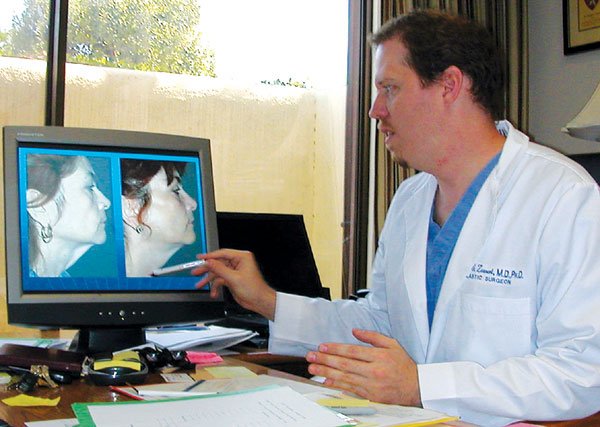Form and function are two of the most essential components of
architecture, and when it comes to the architecture of the human
body, those in need of a retrofit visit a special set of artisans
known as plastic and reconstructive surgeons.
Form and function are two of the most essential components of architecture, and when it comes to the architecture of the human body, those in need of a retrofit visit a special set of artisans known as plastic and reconstructive surgeons.
According to spokeswomen for Saint Louise and Hazel Hawkins hospitals, direct local options are not available in the South Valley for reconstructive surgeons, who specialize not just in enhancement, but the repair of bodily structures damaged by trauma, disease and congenital birth defects.
So residents must turn to specialists in San Jose and Salinas like Dr. Thomas Zewert, a Salinas-based reconstructive specialist trained at Yale and Harvard and a board-certified by the American Society of Plastic Surgeons. He operates a satellite practice in Hollister on Wednesdays.
If the credentials seem a bit specific, it’s for good reason. Technically, no special certification is required for a doctor to practice as a plastic surgeon, said Zewert, and it gives reputable surgeons like him a bad name.
In fact, plenty of clients Zewert sees in the reconstructive portion of his practice are there because unqualified surgeons created unsightly scars, breathing issues or other problems, but he said the reconstructive part of his duties is difficult to separate from the cosmetic end. Technically, reconstructive surgery is supposed to repair the function or operating ability to a body part or system, like clearing the breathing path of a snorer with a deviated septum. But the line between need and personal desire can be a muddy one.
“I don’t think there’s a clear cutoff point between reconstructive and plastic surgery,” said Zewert. “It’s a continuum, really. A lot of ladies now are getting gastric bypass surgery and when that happens people can lose 100 to 150 pounds. What can happen is that excess skin and fat left over gets in the way and creates a fold we call the overhanging pannus.”
Zewert pulls up a series of photos depicting one such patient. Loose skin flaps hang over from her belly to mid-thigh, obstructing her ability to walk as well as causing rashes and embarrassment.
“She sort of looks like a Shar-pei,” said Zewert, but the pictures reveal a dramatic change, as three surgeries later, the excess skin is gone and the woman’s body looks at least 20 years younger.
What was necessary and what was cosmetic? It’s all a matter of perspective, and fine print. Most insurance companies consider skin removal on the back side of the body to be a cosmetic procedure as it does not restrict movement, said Zewert, and the claims process often becomes a negotiation battle.
Further confusing the issue is the fact that some surgery deemed reconstructive is actually cosmetic.
“I operated on a girl named Allison who had a rare condition called Crouzon’s syndrome,” said Zewert, referring to a congenital birth defect that leads to an underdevelopment of the facial bones. Sufferers have essentially flat faces because, while their bodies have grown, their bones do not grow out to support structures like the cheeks, nose and upper jaw. “All I’m doing to her is purely cosmetic work, but it’s covered. Am I making anything work better? No. But what I am doing is building her spirit.”
And spirit lifting is something plenty of reconstructive patients could use. For those stricken by cancer, reconstructive surgery can be an especially meaningful step on the road to physical and emotional recovery.
Reconstructive surgeons can rebuild noses and cheeks, even breasts for women who have endured mastectomies, complete with delicate work like simulated nipples and areolas.
But when it comes to changing lives for other reasons, surgeons are more skeptical. Zewert is particularly wary of television shows that feature large amounts of plastic surgery.
“I think they do a little too much at one time,” said Zewert. “Once you start doing operations over six hours, that puts a lot of physiological stress on a person and there’s only so much you can do safely in a timeframe like that. I’m really conservative in my time zone because these are cosmetic procedures, and I don’t want to risk the patient’s life over them.”
But it’s not just a patient’s physical health Zewert is worried about. Such shows at least allude to if not portray the idea that, with superficial changes to a person’s appearance, they can give the participants a better or happier life, he said.
Zewert spends extensive periods of time with each client during his or her initial consultation, probing to find the motivations behind the desire for surgery.
An ideal candidate, he said, would be someone who was happy with life and with him or herself as a person, but had a nagging physical issue that that person would prefer to be without.
“If someone comes in my office and says they want plastic surgery to make their life better, when they leave they’ve got two things: Their parking validated and a referral to a psychologist if they’ll take one,” said Zewert. “They’re not psychologically healthy enough if they think that getting their nose fixed or their face lifted is going to get them a marriage partner or that it’s going to get them a job.”
For well-adjusted individuals seeking plastic surgery, Zewert recommends doing plenty of research before going under the knife.
“The American Board of Plastic Surgery is the only specialty board for the field that is credentialed by the American Medial Association and the American Board of Medical Specialties,” said Zewert. “People who make this board are trained in general surgery and they had to compete for these very competitive plastic surgery fellowships. These are the best-trained and motivated doctors you’re going to find.”
The board is so strict that doctors displaying their pamphlets must not only by certified by the them, but obtain written permission before attaching their office information to the booklets, but such certification carries weight.
In order to be eligible for the board’s certification, a doctor must complete five years of surgical training in a credentialed facility within the United States or Canada, then sit for extensive written and oral tests, according to Terry Cullison, administrator for the American Board of Plastic Surgery.
“We are one of the 24 recognized medical specialty boards that comes under the umbrella of the Board of Medical Specialties,” said Cullison. “There are rules of medical examinations that the ABMS has to approve. Those are standards of training and standards of testing. The difference then between our board and other boards is we call them self-designated. They’re developing themselves, and there’s no overseeing body they belong to. They may be very up to the AMA standards or they may not be. You don’t know.”
Other board names are offered by cosmetic surgeons, but Zewert advises patients to do plenty of research.
“It’s sad that people are getting butchered,” said Zewert. “There’s one board called the American Board of Cosmetic Surgery, but there’s no qualification for them. You don’t even have to be a surgeon to be on it, and it’s just a board these kind of charlatans have made up.”
Two of the most reputable boards in the industry, outside of the Board of Plastic Surgery are the American Society of Plastic Surgeons and the American Society of Aesthetic Plastic Surgeons, according to Cullison.
“The American Society of Plastic Surgeons is a very reputable group that requires all of its members to be certified either by us or Canada’s Royal College of Plastic Surgeons,” said Cullison. “In both of these cases there are standards for members.”
But despite differences in standards and quality, even other doctors are not immune from taking a skeptical view of all plastic surgeons, said Zewert.
Patients can be most assured of a doctor’s qualifications based on where that doctor operates, he said.
“I think it’s critical to do it in a licensed surgical center with a doctor who has hospital privileges,” said Zewert. “That’s where you can get by these guys who have certificates you can get by sending in 10 Wheaties box tops.”
More information
For more information on any of the plastic surgery boards listed in this article, please visit their Web sites. The American Board of Plastic Surgery can be found at www.ABPLSurg.org and the American Society of Plastic Surgeons can be looked up at www.PlasticSurgery.org. For more information on the American Society of Aesthetic Plastic Surgeons, visit www.Surgery.org.













